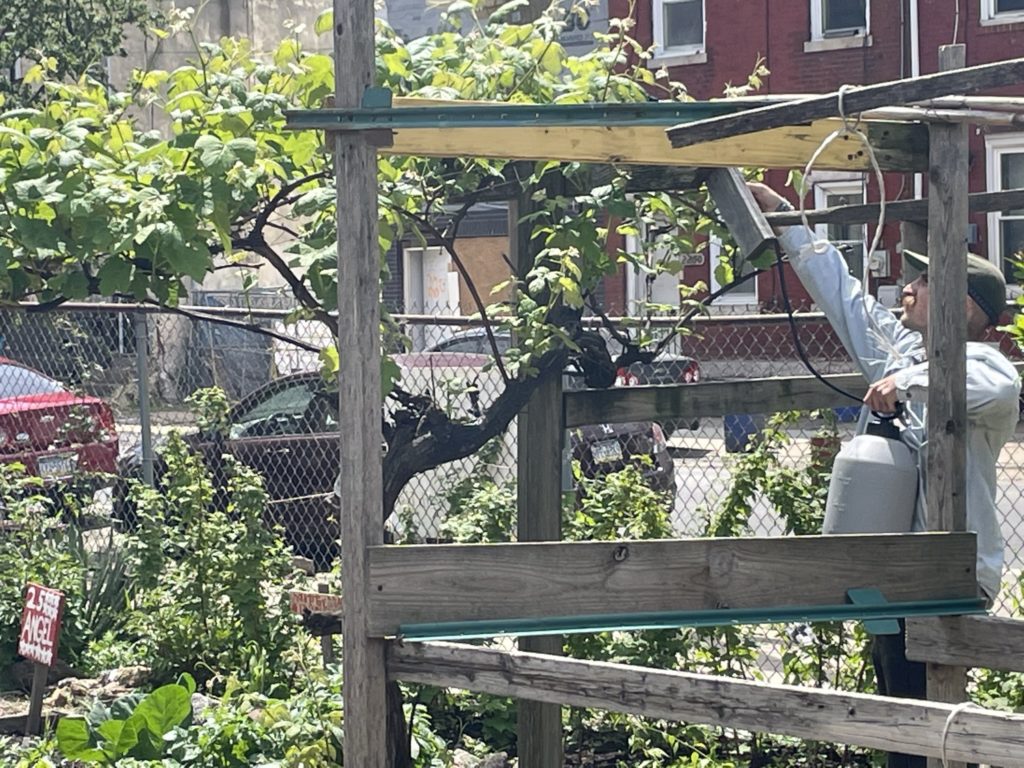Spraying biofungicides on your tree to suppress diseases is like releasing beneficial insects in your orchard to decrease pest populations.
Sometimes when I think about plant disease, about fungi or bacteria, and what is actually happening – my mind just kind of blurs out. I can’t really picture it, I don’t get it. What is actually happening? It seems so mysterious. So before diving straight into what are biofungicides and how they work, let’s set the stage a bit.


Youth from Village of the Arts after-school program practicing different methods of pest and disease management. Photo Credit: POP
When addressing pest and disease issues, there are three different types of controls.
Cultural controls refers to a well-rounded set of techniques that are used to alter (control) the environment around the plant in order to decrease pest and disease populations and/or avoid injury to the crop. This is the bulk of what eco-orcharding is comprised of – it’s why we prune, thin, mulch, sanitize, almost everything. Things done to physically alter the environment around the plant to decrease pest or disease populations or avoid injury to the crop – that’s cultural control.
Chemical controls are using chemicals (organic or otherwise) to prevent, repel, or kill pests or pathogens. For example, one option for treating fire blight in your pear tree is to apply a series of copper sprays. The copper will create an unfriendly barrier on the tree, killing the bacterial pathogen on contact. But like many chemicals, it may become less effective over time, and is potentially harmful to soils, waterways, and people.
Biological controls use living organisms (often predator, parasite, or pathogen) to control pest or disease populations. Releasing beneficial insects like green lacewings to decrease aphid populations is a great example. Biofungicides are also a great example. Biofungicides are fungicides that contain living microorganisms as the active ingredient. Specific strains of (mainly bacterial and fungal) microorganisms that naturally live in soils or on plant surfaces and have been found to effectively control or reduce certain pathogens when applied with good timing. These collected microbes go through a fermentation process that multiplies populations creating the active ingredient of sprays called biofungicides.

Photo Credit: POP.
Serenade and Regalia
Commercially available biofungicides are a relatively new option in the organic growing toolkit. Serenade and Regalia are two biofungicide products that have begun to receive more attention and broader use. As you will read below, they operate in very different ways. POP is piloting the use of these biofungicides as part of a holistic spray regimen at a few of our community orchards and we look forward to sharing further results and recommendations!
Serenade is a biofungicide that can be used in the orchard for treating fire blight, apple scab, powdery mildew, and black knot among others. The active ingredient is a unique strain of Bacillus subtilis (QST 713), which is a bacterium found in the soil. Bacillus subtilis works in several ways:
- Colonizing roots surfaces and growing alongside plant roots. The bacillus subtilis not only creates protective armor around roots shielding from pathogens, but grows stronger root system allowing for better nutrient uptake.
- Colonizing flowers, leaving less space for pathogens.
- Directly attacking fungal pathogens.
- Stimulating plants immune system.
- Preventing spore germination of specific pathogens.
How to Use it
Serenade is much more effective if it’s given the competitive advantage of being present before the pathogen has built up its population – making it most effective in low to moderate cases. Different timing is required depending on the fruit and pathogen involved, but most sprays will take place during the early spring as the flowers open through petal drop, repeating at 7 day intervals. Spraying according to bud stage allows you to spray less and have better protection.
Serenade is compatible with most other sprays including copper. Using a sprayer is the best way to apply. If the spray dries before rainfall, it will not wash off, rainfast. Always read and follow product labels for specific instructions on mixing and compatibility.



From left to right: Fire blight, Black Knot (Photo Credit: POP), and Apple Scab (Photo Credit: Creative Commons), three diseases that can be treated by Serenade.
Regalia is a biofungicide derived from the extract of Giant Knotweed used to prevent and treat fire blight, powdery mildew, botrytis, and potentially other pathogens as well. Instead of working by being a coating protectant or by attacking pathogens directly, Regalia works on the plant internally by:
- Stimulating plants immune response.
- Thickening plant cell walls, making it harder for pathogens to penetrate.
- Promoting plant growth by stimulating production of chlorophyll and phytohormones.
How to Use it
Best to apply before or at first sign of disease and then every 7-10 days for 3 rounds. Timing of spray should aim to be at or around pre-bloom, early bloom, and full or post bloom. Disease resistance takes 1-2 days to build. Rainfast after 1 hour of application. It has a 4 hour re-entry period and a zero day pre-harvest. It is not harmful to people, soil, waterways, or pollinators. Always read and follow product labels for specific instructions on mixing and compatibility.
Where to Purchase Biofungicides
Both Serenade and Regalia are available at a wide variety of online suppliers of organic growing products. Serenade is also fairly commonly available at many garden centers.
Sources and More Info
https://www.growingproduce.com/fruits/apples-pears/prevent-fire-blight-with-biological-controls/
https://ucanr.edu/blogs/blogcore/postdetail.cfm?postnum=13543
https://www.shonnards.com/wp-content/uploads/2015/12/spray_schedule.pdf
https://gardenerspath.com/how-to/organic/bacillus-subtilis/
https://www.7springsfarm.com/products/serenade-aso-2-5-gallon#dynamic-video
This blog post was prepared by POP Education Director, Corrie Spellman-Lopez.
SUPPORT US! If you found this entry useful, informative, or inspiring, please consider a donation of any size to help POP in planting and supporting community orchards in Philadelphia: phillyorchards.org/donate.